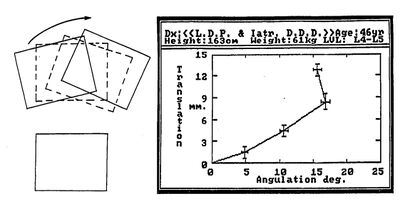Lumbar Instability: Difference between revisions
No edit summary |
m (→Biomechanics) |
||
| Line 11: | Line 11: | ||
'''Neutral zone''': A significant decrease in the capacity of the stabilising system of the spine to maintain the intervertebral neutral zones within the physiological limits so that there is no neurological dysfunction, no major deformity, and no incapacitating pain. The neutral zone is similar to the length of the toe phase of the stress strain curve (see [[Lumbar Spine Biomechanics]]). The joints are loose in early range with excessive displacement, but their ultimate strength may be normal. | '''Neutral zone''': A significant decrease in the capacity of the stabilising system of the spine to maintain the intervertebral neutral zones within the physiological limits so that there is no neurological dysfunction, no major deformity, and no incapacitating pain. The neutral zone is similar to the length of the toe phase of the stress strain curve (see [[Lumbar Spine Biomechanics]]). The joints are loose in early range with excessive displacement, but their ultimate strength may be normal. | ||
'''Instability factor:''' Terminal instability is the behaviour of a system at its endpoint with a sense of impending failure. This can also be seen as the quality of movement during complete range, not just at terminal range. This can be viewed through a lens of the amount of translation and rotation that occurs during sagittal movement of the lumbar spine. Normal lumbar segments have a uniform ratio of translation to rotation. Instability could be seen as an abnormal change of this ratio at any point in movement within normal range, but it may be stable at end range. This type of instability can be viewed by taking serial radiographs during range of motion, and calculating the ratio of the sums of incremental movement. Mean and standard deviations have been reported. and an abnormal instability factor can be defined as being outside two standard deviations. Patients with degenerative disc disease have larger instability factors compared to controls, with increased translation relative to rotation with movement from extension to flexion.<ref name=":0" /> | '''Instability factor:''' Terminal instability is the behaviour of a system at its endpoint with a sense of impending failure. This can also be seen as the quality of movement during complete range, not just at terminal range. This can be viewed through a lens of the amount of translation and rotation that occurs during sagittal movement of the lumbar spine. Normal lumbar segments have a uniform ratio of translation to rotation. Instability could be seen as an abnormal change of this ratio at any point in movement within normal range, but it may be stable at end range. This type of instability can be viewed by taking serial radiographs during range of motion, and calculating the ratio of the sums of incremental movement. Mean and standard deviations have been reported. and an abnormal instability factor can be defined as being outside two standard deviations. Patients with [[Lumbar Degenerative Disc Disease|degenerative disc disease]] have larger instability factors compared to controls, with increased translation relative to rotation with movement from extension to flexion.<ref name=":0" /> | ||
== Anatomy == | == Anatomy == | ||
Revision as of 10:00, 13 September 2021
The term instability as it pertains to the lumbar spine is controversial.
Biomechanics

Instability is when a small load causing an abnormally large or catastrophic displacement. There is no gold standard definition for instability of the lumbar spine. The concept has been viewed through different lenses
Stiffness: A loss of spinal motion segment stiffness such that a force application to the structure produces a greater displacement(s) than would be seen in a normal structure, resulting in a painful condition, the potential for progressive deformity, and that places neurologic structures at risk. This doesn't cover the idea that a small load causes a large displacement, and loss of stiffness may simply be hypermobile segments not at risk of catastrophic collapse. Bogduk suggests the term hypermobility or segmental looseness be applied here instead.
Neutral zone: A significant decrease in the capacity of the stabilising system of the spine to maintain the intervertebral neutral zones within the physiological limits so that there is no neurological dysfunction, no major deformity, and no incapacitating pain. The neutral zone is similar to the length of the toe phase of the stress strain curve (see Lumbar Spine Biomechanics). The joints are loose in early range with excessive displacement, but their ultimate strength may be normal.
Instability factor: Terminal instability is the behaviour of a system at its endpoint with a sense of impending failure. This can also be seen as the quality of movement during complete range, not just at terminal range. This can be viewed through a lens of the amount of translation and rotation that occurs during sagittal movement of the lumbar spine. Normal lumbar segments have a uniform ratio of translation to rotation. Instability could be seen as an abnormal change of this ratio at any point in movement within normal range, but it may be stable at end range. This type of instability can be viewed by taking serial radiographs during range of motion, and calculating the ratio of the sums of incremental movement. Mean and standard deviations have been reported. and an abnormal instability factor can be defined as being outside two standard deviations. Patients with degenerative disc disease have larger instability factors compared to controls, with increased translation relative to rotation with movement from extension to flexion.[1]
Anatomy
References
Bogduk. Instability In: Clinical and radiological anatomy of the lumbar spine. Elsevier 2012

